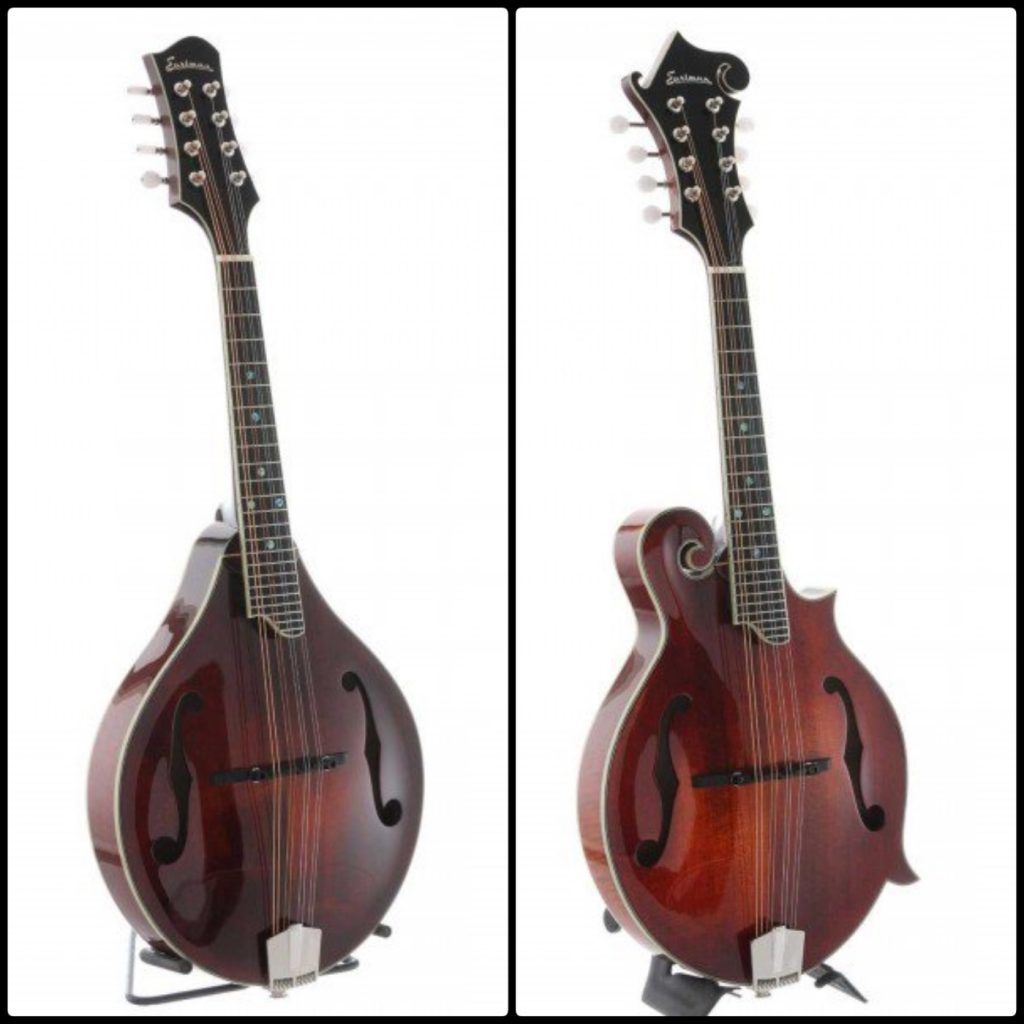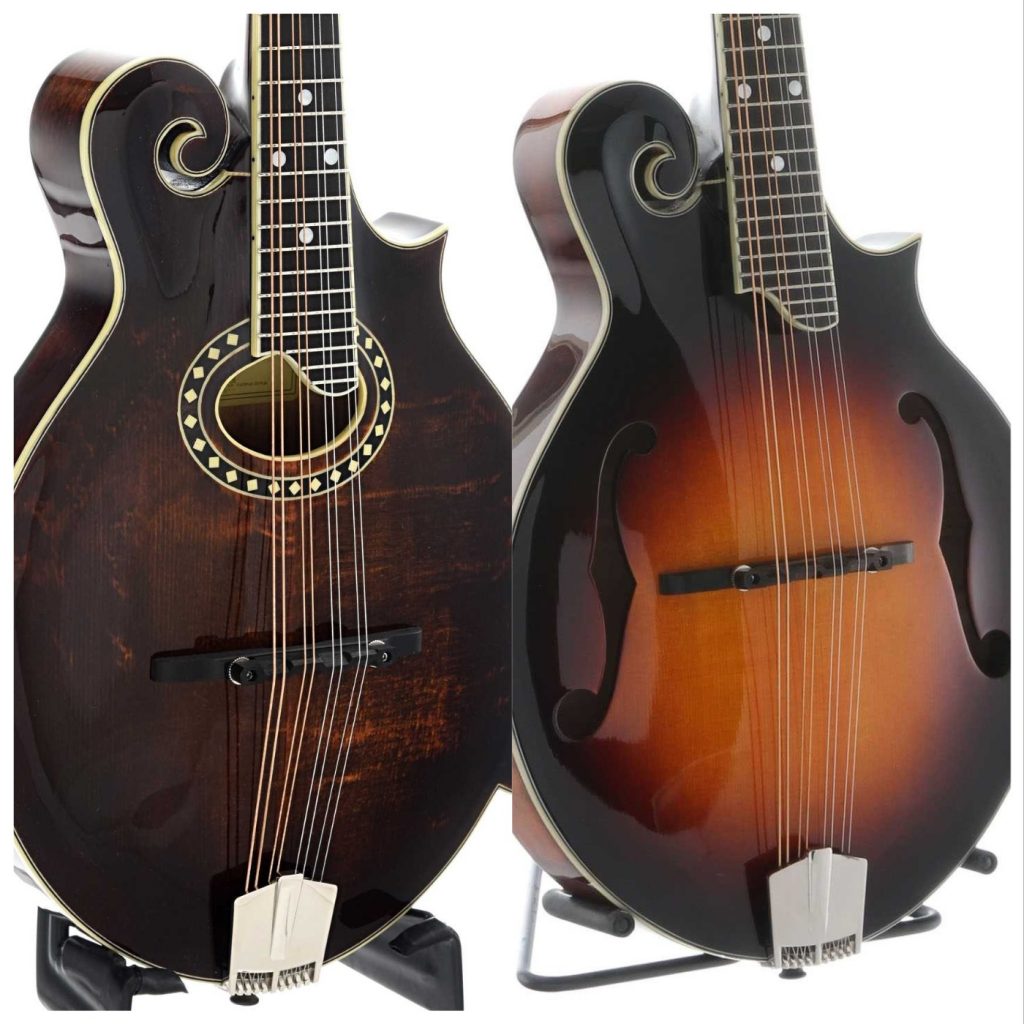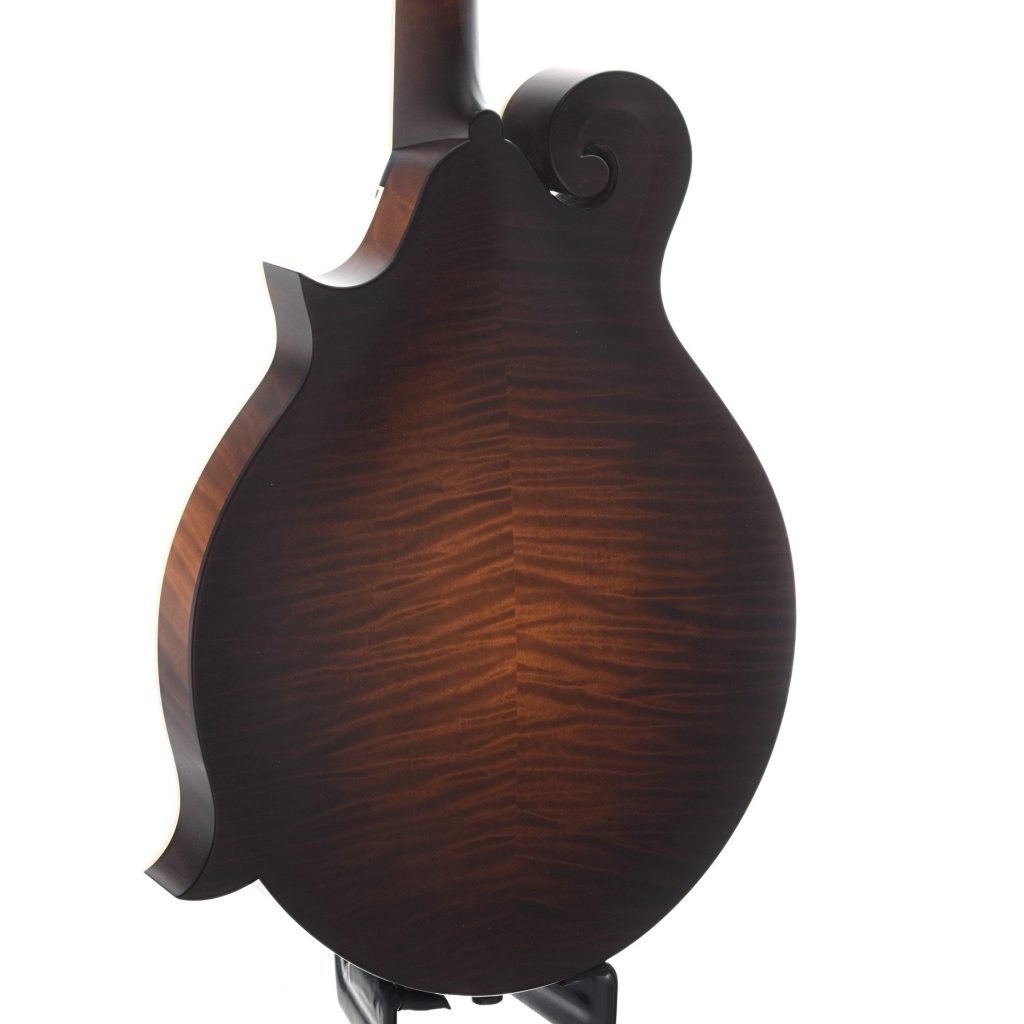So you’re thinking about buying your first mandolin. Maybe you’re a guitarist looking to add some new sounds to your repertoire. Or maybe you went to a bluegrass show and were inspired to learn how to play. In any case, you’ve been bitten by the mandolin bug and need some help. Well, we’ve got the remedy for your Mandolin Acquisition Syndrome. With over 100 mandolins in stock, we can help you find a quality instrument the fits your style and budget.
So what should you be looking for? We’ve put together a list of 6 questions that will help you narrow down your options. There’s a limitless number of mandolin variations, and we can only cover a few here, but if we take a look at 6 of the biggest choices, that will at least get you in the right neighborhood. So let’s get started.
1) F-style or A-style — or Something Else?
Most commercially available acoustic mandolins fall into one of two body styles: A-style or F-style. These styles were created by Orville Gibson, the founder of Gibson, in the late 1800s and early 1900s. While most mandolins at the time were made in the Italian style, with a multi-piece bowl-shaped back and mostly flat canted top, Gibson developed mandolins that drew inspiration from violins, which feature gently arched tops and backs. The simpler of Gibson’s two mandolin styles, the A-style, featured a symmetrical teardrop shaped body. The F-style, on the other hand, featured a decorative scroll on the upper bass side bout and multiple points sticking out from the body. These mandolins were so popular that Gibson’s nomenclature has become the industry standard, and most mandolins produced today are modeled after these two styles.
 A-style mandolin (left) vs. an F-style mandolin (right)
A-style mandolin (left) vs. an F-style mandolin (right)
So how does the body style affect the sound of an instrument? This is where things get a little messy. Some players argue that body style is entirely aesthetic and has no perceivable impact on the sound, while others argue that the extra mass of the F-style’s decorative elements must affect the overall tone somehow. Most players seem to agree, however, that other factors — such as quality of tonewood, level of craftsmanship, and type of soundhole — are much more important in determining an instrument’s sound. If price is a significant consideration, you will usually find that A-style mandolins are less expensive than F-style mandolins of comparable quality, due to the extra work required to make the scroll and points.
There are some other body styles out there, including guitar-shaped bodies, modern bowl back mandolins, and bodies with points on both upper bouts (sometimes called double cutaway style), but most acoustic mandolins you encounter will be either A-style or F-style instruments.
2) Do Soundholes Matter?
When it comes to soundholes, most commercially available mandolins again fall into two categories: those with f-holes, like a violin, and those with round (usually oval-shaped) soundholes, similar to a guitar.
 Oval soundhole (left) vs. f-holes (right)
Oval soundhole (left) vs. f-holes (right)
Broadly speaking, f-holes provide bright, clear tone, while round soundholes provide warm, sustaining tone. This is an oversimplification, though, and results will vary from instrument to instrument, depending on tonewoods and other construction details. Mandolins with f-holes will almost always be louder than those with oval soundholes, so if you’re going to be playing in acoustic situations like a bluegrass jam where you need to compete with a banjo, an instrument with f-holes may be your best option.
Because of these differences, bluegrass players tend to prefer mandolins with f-holes, while those who play old time or Celtic music tend to prefer round soundholes, but you will find plenty of exceptions on either side. Type of soundhole is an important consideration, but don’t be afraid to try out instruments with both types to find the sound you prefer.
3) What Kind of Tonewoods Should I Look For?
Mandolins usually feature a pair of tonewoods. The back and sides are most often made from maple, which is prized for its clarity. The most common wood for the top of the instrument is spruce, but the variety of spruce can have a significant effect on the sound of a mandolin.
Sitka spruce is the most common variety, and it provides clear, balanced tone that retains its focus at loud volumes. Engelmann spruce offers warmer, more complex tone that responds well to a lighter touch. Adirondack spruce was the most common top wood on pre-World War II instruments, but over-harvesting made quality Adirondack spruce hard to find for many years. It is re-emerging as an available tonewood, offering clear, focused tone that stands up to heavy playing.
Red cedar is occasionally used for tops, giving the mandolin a warm, lively sound. Backs and sides are sometimes made with mahogany, which can give a spruce-topped instrument a punchy, woody tone.
 A figured/flamed maple back.
A figured/flamed maple back.
Instruments made from solid wood are more generally more desirable than instruments made from laminated wood. Solid tops and backs can either be carved or pressed into an arch shape, and either method can produce fine results. You may also see words like “flamed” or “highly figured” used to describe tonewoods, particularly on the backs of instruments. These describe dark patterns in the wood grain that many find visually appealing. These figurations shouldn’t affect an instrument’s sound, but they do add a visual richness to the instrument.
You may also find A-style mandolins with flat back and sides, similar to an acoustic guitar. While these were originally produced as budget models because they are easier to build, many players like the sound and look of these interesting instruments.
You should try out as many tonewood combinations as you can get your hands on to find one that fits your style and sound
4) Should I Get a Mandolin With a Pickup?
If you’re going to be playing mostly at home or in acoustic jam sessions, you may never need a pickup. If you plan on playing in medium to large venues, however, you should explore some pickup options. Some mandolins come equipped with a factory-installed pickup system, but there are plenty of minimally invasive aftermarket pickups that work very well. Many of these pickups need to be installed under the bridge, so professional installation is advised. Most mandolin pickups are passive, as opposed to the active pickups found on many acoustic guitars. Without getting too deep into wiring and electrical engineering, the important thing you need to know is that active pickups use a power source, usually a 9V battery, to boost the instrument output. Passive pickups send a less powerful signal, so you may want to invest in a good preamp and/or direct box to boost your signal.
Another option is a solid body electric mandolin. These are great for playing loud clubs, using electric guitar-style effects pedals, or in other situations where feedback is a concern. If you want to bring them to a campfire jam, though, you’ll have to pick up a battery powered amplifier.
5) What is Nut Width, Anyways?
The nut is the piece at the end of the fingerboard where the neck meets the headstock. Measuring nut width tells you the width of the neck at that point. The wider the neck, the farther apart the string courses are spaced. A nut width of 1 1/8” is the most common, but many mandolins feature a slightly larger 1 3/16” nut. While 1/16th of an inch may not seem like much, it makes a big difference in how the instrument feels. Players with larger hands or players switching from guitar may prefer the wider 1 /3/16” nut. If possible, try to sit down with one of each to compare how they feel in your hands.
6) Are There Other Types of Mandolins?
The mandolin is tuned similarly to the violin, which is great news for violinists looking to pick up the mandolin or new mandolin players who are itching to learn some fiddle tunes. And like the violin and its orchestral relatives, the mandolin has a whole family of related instruments. Mandolas are tuned lower than mandolins, similar to violas, giving them a mellower tone. Below that is the octave mandolin, tuned a full octave lower than a standard mandolin. The bouzouki is similar to the octave mandolin, but it usually has longer scale length and sometimes features octave courses instead of unison courses on its lower two courses. Bouzoukis and octave mandolins have different tonal characteristics, so it’s wise to try both before you buy one.
Then there’s the mandocello, which is tuned — you guessed it — like a cello, an octave below the mandola. There is also the rare mandobass, which is tuned similar to an upright bass. The mandola, octave mandolin, and mandocello are all nice instruments with rich timbre. The mandobass, however, is a bit of a novelty and not very useful in most musical contexts.
There are also hybrid instruments like the banjo mandolin, which features a mandolin neck and a banjo body. These are fun instruments that combine the brightness of a mandolin with the meaty plunk of a banjo. There are also resonator banjos, which have a metal amplifying cone built into the body of the instrument. Another intriguing hybrid is the Manditar, which uses a large mandolin body, wider neck, and 6 or 12 strings tuned like a guitar, but an octave higher. It’s a great options for guitarists looking to add mandolin-like sounds to their arsenal.
And … Go!
Hopefully these questions give you some direction in your search for a mandolin. The best thing to do, if you have the opportunity, is to try a bunch of different instruments and see what suits your taste. There are a lot of fine mandolins out there. But don’t stress too much about getting the perfect instrument right away. Find something that’s in your budget and that you enjoy playing, and as you progress, you may find another mandolin that better suits your approach. Just ask a seasoned mandolinist, the search for the “perfect” mandolin is a never-ending quest, but with any luck, you’ll find some gems along the way. And whenever you’re ready to try something new or get some mandolin advice, we’ll be here for you.
